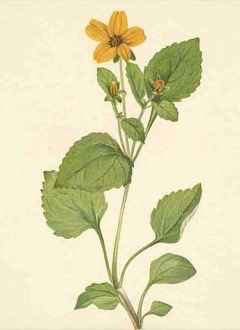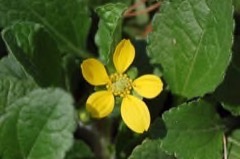 |
|
edibleplants.org |
 |
| Derek Ramsey (Ram-Man) wikimedia.org |
Translate this page:
Summary
Physical Characteristics

 Chrysogonum virginianum is an evergreen Perennial growing to 0.2 m (0ft 8in) by 0.4 m (1ft 4in) at a fast rate.
Chrysogonum virginianum is an evergreen Perennial growing to 0.2 m (0ft 8in) by 0.4 m (1ft 4in) at a fast rate.
See above for USDA hardiness. It is hardy to UK zone 6.
It is noted for attracting wildlife.
Suitable for: light (sandy), medium (loamy) and heavy (clay) soils and prefers well-drained soil. Suitable pH: mildly acid and neutral soils and can grow in very acid soils.
It can grow in full shade (deep woodland) semi-shade (light woodland) or no shade. It prefers dry or moist soil.
UK Hardiness Map
US Hardiness Map
Synonyms
Chrysogonum australe Alexander ex Small, syn of var. australe.Diotostephus repens Cass., syn of var. brevistolon
Plant Habitats
Edible Uses
References More on Edible Uses
Medicinal Uses
Plants For A Future can not take any responsibility for any adverse effects from the use of plants. Always seek advice from a professional before using a plant medicinally.
None known
References More on Medicinal Uses
The Bookshop: Edible Plant Books
Our Latest books on Perennial Plants For Food Forests and Permaculture Gardens in paperback or digital formats.

Edible Tropical Plants
Food Forest Plants for Hotter Conditions: 250+ Plants For Tropical Food Forests & Permaculture Gardens.
More

Edible Temperate Plants
Plants for Your Food Forest: 500 Plants for Temperate Food Forests & Permaculture Gardens.
More

More Books
PFAF have eight books available in paperback and digital formats. Browse the shop for more information.
Shop Now
Other Uses
C. virginianum spreads slowly via stolons to form a groundcover. Wildlife Habitat: A host wildlife such as reptiles, mammals, and songbirds. Insectary: The flowers provide nectar to pollinators. Ornamental Green and Gold is often planted ornamentally for its light green triangular foliages and golden star-shaped flowers. There are a number of named cultivars selected for ornamental properties[318-1].
Special Uses
Attracts Wildlife Food Forest Ground Cover
References More on Other Uses
Cultivation details
A low growing herbaceous perennial with starry golden daisy-like flowers native to the USA. Easily grown in average, medium moisture, well-drained soils in part shade to full shade. Prefers moist, acidic, organically rich soils in sun-dappled part shade. Tolerates full sun only if grown in consistently moist soils. Spreads by rhizomes to form an attractive ground cover, but is easily controlled[368-1]. Growth Rate: Moderate to Fast. Stand Persistence: Long. Form: Spreading. Texture: Medium. Sun: Full Sun, Partial Shade. Soil Type: Sandy, Loamy, Silty, Clay. Soil Moisture: Moderate. Root Type: Stolon, Fibrous Shallow. Bacteria-Fungal Ratio: 10:1-100:1. Seasonal Interest: Spring-Fall. In the US it grows more upright in northern climates and more prostrate in southern climates. Recommended to naturalize in rain gardens. Best in well-drained soils. Blooms sparsely during the heat of summer. Fruit Type: Achene. Flower Color: Yellow. Soil pH preference: 6.0 - 6.8. Drought: Moderate. Flood: Tolerant. Salt: Intolerant. Soil Compaction: Intolerant. Cold Injury: Moderate. Wind Storm Damage: Infrequent. Disease Issues: Minor. Insect/Pest Damage: Minor. Animal Damage: Deer, Rabbits. Growing Season: Bloom Time: Spring - Fall. Fruit Time: Spring - Fall [318-1]. For polyculture design as well as the above-ground architecture (form - tree, shrub etc. and size shown above) information on the habit and root pattern is also useful and given here if available. The plant growth habit is a clumper with limited spread [1-2]. An evergreen. The root pattern is rhizomatous with underground stems sending roots and shoots along their length [1-2]. Used in the Beach Plum Tree Guild: (Polycultures: Permaculture Activist Magazine February 2013, Eric Toensmeier.) Beach Plum (Prunus maritima) This fruiting shrub can grow to over 12 feet (4 meters) and produces small, delicious plums. Niche: deciduous shrub. Habitat: average water needs, Full to partial sun, Prefered soil types UNKNOWN (assume loamy soil is good?). Notable Products: Edible fruit, Green and Gold (Chrysogonum virginianum) This is a beautiful groundcover that attracts beneficial insects and can grown in partial shade and moist soils. Niche: Ground cover. Habitat: Requires consistently moist soil that drain, Full sun to partial shade, Notable Products: Nectar. Dwarf Coreopsis (Coreopsis auriculata nana) This is another beautiful groundcover that attracts beneficial insects. Niche: Herbaceous perennial. Habitat: Full sun, medium water needs, said to be native to open woods in South Eastern US, so it probably can survive in a variety of soil types. Notable Products: Nectar, pollen. Ramps (Allium tricoccum) a.k.a. Wild Leeks, are early Spring vegetables and grows well in the shade. Niche: Herbaceous perennial. Habitat: Shaded woodlands, average water needs, preferes wet and acid soils. Tolerats juglone. Notable Products: Edible leaves and bulbs. Camas (Camassia quamash) has edible bulbs and has flowers that attract beneficial insects. Niche: Small Herbaceous Plant. Habitat: Full sun to light shade, prefers moist soil, pH: 5.1-7.5 (tolerates a wide range of soil conditions). Notable Products:Nectar, pollen, edible bulb. Notes: This is a polyculture with flowering plum and ground cover, edible Spring vegetables, and edible Camas bulbs.
References Carbon Farming Information and Carbon Sequestration Information
Temperature Converter
Type a value in the Celsius field to convert the value to Fahrenheit:
Fahrenheit:
The PFAF Bookshop
Plants For A Future have a number of books available in paperback and digital form. Book titles include Edible Plants, Edible Perennials, Edible Trees,Edible Shrubs, Woodland Gardening, and Temperate Food Forest Plants. Our new book is Food Forest Plants For Hotter Conditions (Tropical and Sub-Tropical).
Shop Now
Plant Propagation
Easily grown from seed and may self-seed in the garden.
Other Names
If available other names are mentioned here
Golden-knee, Goldenknee, Green and gold, Goldenstar
Native Range
NORTHERN AMERICA: United States, Ohio (east), Pennsylvania (s.-c.), West Virginia, Alabama (south), Florida (northwest), Georgia, Kentucky (southeast), Louisiana (southeast), Maryland (west), Mississippi (southeast), North Carolina, South Carolina, Tennessee (east), Virginia, District of Columbia,
Weed Potential
Right plant wrong place. We are currently updating this section.
Please note that a plant may be invasive in one area but may not in your area so it's worth checking.
None Known
Conservation Status
IUCN Red List of Threatened Plants Status :

Growth: S = slow M = medium F = fast. Soil: L = light (sandy) M = medium H = heavy (clay). pH: A = acid N = neutral B = basic (alkaline). Shade: F = full shade S = semi-shade N = no shade. Moisture: D = dry M = Moist We = wet Wa = water.
Now available:
Food Forest Plants for Mediterranean Conditions
350+ Perennial Plants For Mediterranean and Drier Food Forests and Permaculture Gardens.
[Paperback and eBook]
This is the third in Plants For A Future's series of plant guides for food forests tailored to
specific climate zones. Following volumes on temperate and tropical ecosystems, this book focuses
on species suited to Mediterranean conditions—regions with hot, dry summers and cool, wet winters,
often facing the added challenge of climate change.
Read More
Expert comment
Author
L.
Botanical References
Links / References
For a list of references used on this page please go here
Readers comment
| Add a comment |
|
If you have important information about this plant that may help other users please add a comment or link below. Only comments or links that are felt to be directly relevant to a plant will be included. If you think a comment/link or information contained on this page is inaccurate or misleading we would welcome your feedback at [email protected]. If you have questions about a plant please use the Forum on this website as we do not have the resources to answer questions ourselves.
* Please note: the comments by website users are not necessarily those held by PFAF and may give misleading or inaccurate information.
To leave a comment please Register or login here All comments need to be approved so will not appear immediately.
|
Subject : Chrysogonum virginianum
|
|
|
|